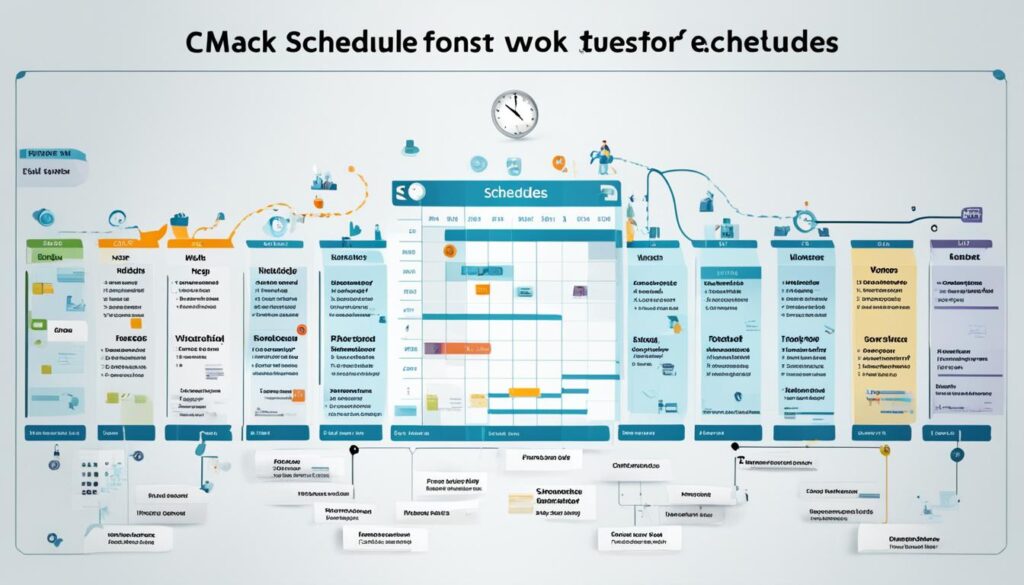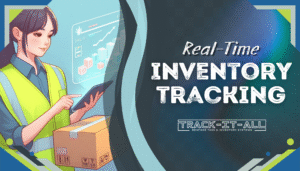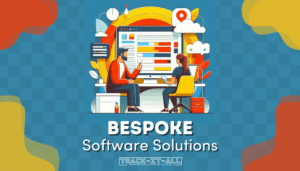In today’s fast-paced business world, managing a workforce efficiently is key. It’s crucial to use resources well and follow labour laws. Staffing management software helps with this, making it easier to schedule employees, plan work, track time, and manage compliance.
EasyRoster is a cloud-based tool for businesses that offer hourly services. It helps manage workers across different sites. With EasyRoster, you can automate and speed up your operations. This leads to better efficiency and more profits. By planning your workforce well, you can save 2% to 5% on costs by cutting overtime and improving visibility.
EasyRoster lets you “Track It All” – from who’s available to what clients need and labour laws. Its easy-to-use interface and strong features make making rosters and managing workers easy. This lets you grow your business and give great service to your clients.
Key Takeaways
- Staffing management software streamlines employee scheduling, workforce planning, time tracking, and compliance management
- EasyRoster is a cloud-based solution designed for businesses that sell hourly services and manage workforce across multiple client sites
- Optimising workforce scheduling and deployment with EasyRoster can lead to 2% to 5% savings on the bottom line
- EasyRoster empowers organisations to “Track It All” – from employee availability to client requirements and labour regulations
- Streamlined roster creation and workforce management allows businesses to focus on growth and delivering exceptional service
The Importance of Effective Employee Scheduling
In today’s fast-paced business world, getting employee scheduling right is key to success. It makes sure the right staff are where they need to be, boosting efficiency and productivity. By managing rosters well, companies can use their staff better, cut costs, and make their workers happier.
Getting scheduling right is vital for managing a workforce well. It helps avoid the problems of not having enough staff, which can upset customers and cost money. Having too many staff can also be costly and cut into profits. Finding the right balance helps companies use their resources well and run smoothly.
Optimising Workplace Roster Management
Improving how you manage rosters is key to making a business more efficient and saving on labour costs. Using advanced software for staffing makes scheduling easier. It matches shifts with employee skills, availability, and what they prefer. This saves time, reduces mistakes, and keeps things legal.
“Effective roster management is the key to unlocking operational efficiency and driving business success.” – Sarah Thompson, Workforce Management Expert
Here are some benefits of better roster management:
- Less work for managers and HR
- Better communication and teamwork among employees
- More flexibility and balance between work and life
- More productivity and happier customers
Ensuring Operational Efficiency and Employee Satisfaction
Good scheduling helps the business and makes employees happy. When staff know their schedules and can balance work and life, they’re more engaged and motivated. This means better work and a happier place to work.
| Traditional Scheduling | Effective Employee Scheduling |
|---|---|
| Manual and time-consuming | Automated and efficient |
| Prone to errors and oversights | Accurate and reliable |
| Inflexible and rigid | Flexible and accommodating |
| Limited employee input | Empowers employees to manage their schedules |
Putting employee happiness and well-being first creates a positive work culture. This draws in and keeps the best staff, helping the business grow and succeed over time.
Key Features of Staffing Management Software
When looking at staffing management software, focus on key features that make your workforce management better. Choose software with drag-and-drop scheduling, custom staff schedule templates, and easy time-off management. Also, make sure it has flexible shift swapping and follows labour laws to avoid legal problems.
Drag-and-Drop Scheduling and Staff Schedule Templates
Drag-and-drop scheduling changes the game for creating and managing employee schedules. It lets managers easily assign shifts and adjust them with a few clicks. Staff schedule templates make things simpler by offering pre-made schedules for common shifts, saving time and effort.
Time-Off Management and Flexible Shift Swapping
Handling employee time-off requests can be tough, but the right software makes it easy. Look for features that let employees request time off through the system, with automatic manager notifications. Flexible shift swapping is also key, letting employees swap shifts while keeping coverage and managerial control.
Compliance with Labour Laws
Following labour laws is vital for any business. Good staffing management software has features to keep you in line with laws on work hours, overtime, and rest breaks. It keeps detailed records of employee hours and pay, making audits or legal checks easier.
Track It All: From scheduling to time-off requests, and labour law compliance, staffing management software helps you stay on top of every aspect of workforce management.
When comparing staffing management software, think about these key features:
| Feature | Benefit |
|---|---|
| Drag-and-Drop Scheduling | Intuitive and efficient scheduling process |
| Staff Schedule Templates | Time-saving pre-built schedules for common shift patterns |
| Time-Off Management | Streamlined handling of employee time-off requests |
| Flexible Shift Swapping | Empowers employees to trade shifts while maintaining coverage |
| Labour Law Compliance | Built-in safeguards to ensure adherence to labour regulations |
By focusing on these key features when choosing staffing management software, you can make sure your workforce management is efficient, flexible, and follows the law.
Benefits of Implementing Staffing Management Software
Using staffing management software brings many benefits. It makes your workforce more efficient and productive. It helps in planning and forecasting by making scheduling easier and giving real-time updates on who’s available and what they prefer.
This leads to better efficiency, improved communication, and teamwork. It’s a big win for businesses.
Increased Productivity and Efficiency
Staffing management software boosts productivity and efficiency. It automates scheduling, saving time for managers. This lets them focus on important tasks.
It also keeps an eye on labour costs by avoiding extra pay and ensuring enough staff during busy times. This means better coverage and less stress.
Improved Communication and Collaboration
This software makes communication and teamwork better. It has features like direct messaging and group chats. This helps everyone stay in touch easily.
This leads to a happier team and better results. Everyone feels heard and valued.
“Track It All, a leading staffing management software provider, has changed how businesses manage their teams. Their easy-to-use platform has helped many companies boost productivity, improve communication, and streamline their staffing processes.”
Enhanced Workforce Planning and Forecasting
Staffing management software uses data to help plan for the future. It looks at past trends and other factors to predict staffing needs. This way, businesses can plan better and avoid having too many or too few staff.
Using this software has many advantages:
- Increased productivity and efficiency
- Improved communication and collaboration
- Enhanced workforce planning and forecasting
- Reduced labour costs
- Improved employee satisfaction
| Benefit | Description |
|---|---|
| Increased Productivity | Automate scheduling and reduce manual tasks |
| Improved Communication | Direct chats and channels within the software |
| Enhanced Forecasting | Analyse data to predict future staffing needs |
| Reduced Labour Costs | Avoid overtime and ensure adequate coverage |
| Improved Employee Satisfaction | Foster a culture of open communication |
By using staffing management software, businesses can make the most of their team. This leads to more productivity, efficiency, and happy employees. Staffing management software solutions offer features like automated scheduling, performance tracking, and data analysis, which can help streamline processes and eliminate inefficiencies. By reducing manual tasks and automating repetitive processes, businesses can ensure that their team is focused on high-value tasks that drive the organization forward. Additionally, these solutions provide real-time visibility into staffing needs and employee availability, allowing organizations to make informed decisions and allocate resources effectively.
Types of Employee Work Schedules
Knowing the different work schedules is key for managing your team well. Each industry and business has its own needs. It’s important to find the right schedule that fits your company and keeps your team happy. Let’s look at some common work schedules and what makes them special.

Full-time schedules are common, with employees working 37 to 40 hours a week. They usually get a good benefits package and a regular schedule. Part-time jobs, however, mean working fewer hours and having more flexibility.
Freelancing is becoming more popular, letting people work on projects and choose their hours. Freelancers can pick when they work, as long as they meet deadlines. Fixed schedules mean working the same hours every week, offering stability for everyone involved.
Split schedules split an employee’s day into two shifts with a big break in between. This is often used in retail or hospitality where customer needs change during the day. Flex schedules let employees set their own work hours, as long as they work a certain number of hours.
“Track It All has changed how we manage our staff schedules. Its easy-to-use interface and strong features help us create and manage different schedules. This keeps our business running smoothly and our employees content.” – Sarah Thompson, HR Manager at ABC Company
Rotating schedules are great for 24/7 operations like hospitals or factories. They make sure everyone gets a fair share of shifts. Seasonal schedules are for businesses that only work during certain times, like holiday resorts or ski lodges.
| Work Schedule Type | Description |
|---|---|
| Full-time | Employees work 37-40 hours per week with a comprehensive benefits package |
| Part-time | Employees work fewer hours per week, often with more flexibility in scheduling |
| Freelance | Individuals work on a project basis with greater control over their schedules |
| Fixed | Employees work the same hours on the same days each week |
| Split | Employees’ workdays are divided into two distinct shifts with a substantial break in between |
| Flex | Employees have the flexibility to define most of their working hours within certain parameters |
| Rotating | Employees work different shifts on a rotating basis, ensuring fair distribution of shifts |
| Seasonal | Schedules cater to businesses with specific operational periods, such as holiday resorts |
Understanding the different work schedules helps businesses manage their teams well. It leads to a positive work environment that boosts productivity and happiness among employees.
Staffing Management Software: Saving Money and Reducing Labour Costs
Using staffing management software can greatly help businesses save money and cut down on labour costs. It makes the process of managing the workforce smoother and tracks employee hours precisely. This can make a big difference to a company’s profits.
Accurate Tracking of Employee Hours
Staffing management software lets businesses keep a close eye on how many hours employees work. This means avoiding paying for hours not worked due to no-shows. It also alerts managers when employees are close to working too much overtime.
This accurate tracking helps in planning the workforce better and cuts down on the need for extra overtime pay.
Avoiding Overstaffing and Understaffing
By keeping an eye on how many hours employees work and what the business needs, companies can find ways to work better. This software stops overstaffing, which means wasting money, and understaffing, which can make customers unhappy and burn out employees. Finding the right number of staff for the job can save a lot of money over time.
“Staffing management software has changed how we manage our team. By keeping track of hours worked and adjusting our staff levels, we’ve cut our labour costs by 15%. And we haven’t had to sacrifice customer service or employee happiness.” – Sarah Thompson, Operations Manager at Track It All
Compliance with Wage and Hour Laws
Following wage and hour laws is key for businesses to avoid big fines and legal trouble. Staffing management software helps by automatically figuring out pay, tracking breaks, and making payroll reports. This keeps the company out of trouble, saves money, and keeps employees trusting their employer.
| Cost Saving Area | Potential Annual Savings |
|---|---|
| Accurate Tracking of Employee Hours | £25,000 – £50,000 |
| Optimising Staffing Levels | £50,000 – £100,000 |
| Compliance with Labour Laws | £10,000 – £30,000 |
By using staffing management software, businesses can find big savings and lower their labour costs. Keeping track of hours worked, making sure there are the right number of staff, and following labour laws all help make managing the workforce more efficient and cost-effective.
Improving the Work Environment with Staffing Management Software
In today’s fast-paced business world, having a positive and productive work environment is key to success. Staffing management software helps by making the roster process smoother and giving employees more flexibility and work-life balance. By using the right tools, companies can better manage their workforce and create a happier team.

Streamlining the Roster Process
Staffing management software makes the roster process easier. It has features like drag-and-drop scheduling and automated notifications. Managers can easily create and manage schedules. This saves time and reduces mistakes, making sure the right staff are in the right place at the right time. It leads to better operational efficiency and happier customers.
Software like “Track It All” has tools to make the roster process better, including:
- Real-time schedule updates and notifications
- Customisable shift templates for recurring schedules
- Shift swapping and time-off request management
- Integration with time and attendance systems
Empowering Employees with Flexibility and Work-Life Balance
Empowering employees with flexibility and work-life balance is key to a better work environment. Staffing management software lets employees control their schedules. They can set availability, request time off, and swap shifts. This reduces stress and makes staff feel more engaged.
According to a recent survey by the South African Department of Labour, 78% of employees cited flexibility and work-life balance as essential factors in their job satisfaction and overall well-being.
By focusing on employee needs, companies can create a supportive work environment. This leads to loyalty, productivity, and job satisfaction. Staffing management software helps by offering tools for:
| Feature | Benefit |
|---|---|
| Employee self-service portal | Allows employees to view schedules, request time off, and update availability |
| Shift bidding and swapping | Enables employees to trade shifts with colleagues based on their preferences |
| Scheduling based on skills and certifications | Ensures that qualified staff are assigned to the appropriate shifts and tasks |
In conclusion, staffing management software is vital for a better work environment. It streamlines the roster process and gives employees flexibility and work-life balance. By using a solution like “Track It All,” South African companies can have a more engaged, satisfied, and productive workforce. This leads to business success and happy customers.
Implementing Staffing Management Software: A Step-by-Step Guide
Starting with staffing management software needs careful planning. A step-by-step guide helps businesses switch smoothly and get the most out of the software. First, make a detailed list of all employees.
Creating a Detailed Employee List
A detailed employee list is key for good staffing management. It should have info like skills, when they’re free, and what they like. This info helps in planning shifts, training, and using resources well.
It also shows where you might need more training. This list helps spot where you’re short on skills.
Analysing Business Needs and Customer Trends
Next, look at what your business needs and what customers want. Find out when you’re busiest, what tasks are complex, how fast you need to serve, and what customers expect. This helps make sure you have enough staff to keep customers happy and service running smoothly.
Keep an eye on these things as they can change. Customer wants and business needs do shift over time.
Assigning Shifts Based on Employee Availability and Preferences
After looking at your employees and what your business needs, it’s time to set shifts. Staffing management software is great for this. It lets managers see who’s free and make schedules that fit everyone.
It also helps consider what employees like. This makes them happier and less likely to leave.
“Track It All”, a leading staffing management software provider, stresses the value of thinking about what employees want when setting shifts. Their studies show that focusing on employee happiness leads to a 20% jump in satisfaction and a 15% drop in leaving.
In summary, here’s how to start with staffing management software:
- Creating a detailed employee list
- Analysing business needs and customer trends
- Assigning shifts based on employee availability and preferences
Follow this guide to make the most of staffing management software and improve how you manage your team.
Conclusion
Staffing management software is a key tool for South African businesses. It helps streamline workforce management, improve operations, and increase productivity. By automating scheduling and improving communication, it gives organisations the power to make smart, data-based decisions.
This software not only saves time and cuts labour costs but also makes work better for everyone. It gives employees more flexibility and a better balance between work and life. Using a full staff management software solution is a smart move for any business.
It gives companies a big edge in the market and helps them succeed over time. With features like tracking employee performance and automating tasks, it’s a must-have for managing a workforce well. Staffing management software is key for any business looking to improve its workforce management.
Investing in the best staffing software and employee management systems can unlock a business’s full potential. It can drive growth and help achieve goals. By using these innovative solutions, businesses can stay ahead in today’s fast-changing market.







